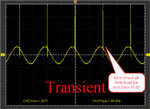Max++
Junior Member level 3
I'd like to generate the transient in power line system from D/A as image below.

There are 2 points that I want to know including.
1. How to amplifying small signal from D/A to very high voltage 220V?
2. How can I accomplish the rise/fall time of such level (10uSec at more than 500V)?
This signal is just voltage based supply to power analyzer. It is not drive to actual load anymore.
So, the current can be very small.
Please guide me to design the amplifier and appreciate if anyone can advise devices/or circuit that I should use in this design?
Thank in advance.

There are 2 points that I want to know including.
1. How to amplifying small signal from D/A to very high voltage 220V?
2. How can I accomplish the rise/fall time of such level (10uSec at more than 500V)?
This signal is just voltage based supply to power analyzer. It is not drive to actual load anymore.
So, the current can be very small.
Please guide me to design the amplifier and appreciate if anyone can advise devices/or circuit that I should use in this design?
Thank in advance.